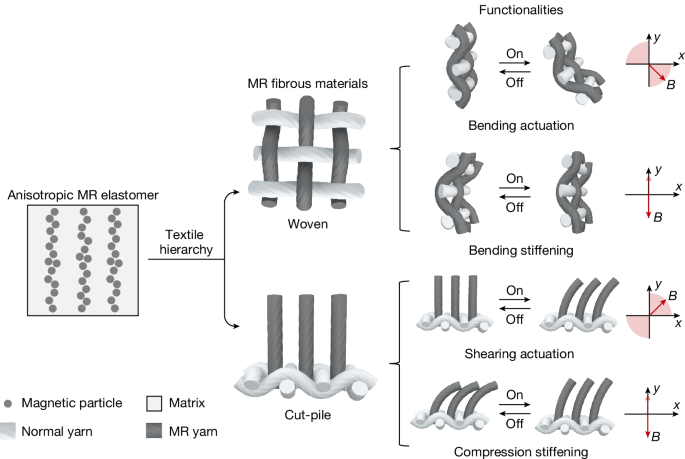
"Magnetorheological (MR) materials, a class of smart materials that can reversibly change rheological and mechanical properties under magnetic fields15,16,17, are composed of soft magnetic particles within a fluid or elastomeric carrier18,19. Under external magnetic fields, the magnetized particles attract each other through dipole-dipole interaction to form fibre-like structures-known as the MR effect-that increase the viscosity and stiffness of the MR materials20,21. Among these materials, anisotropic MR elastomers with predefined fibre-like soft magnetic structures exhibit directional responses, including sheer stiffening22 and rotational actuation23, to magnetic fields."
"However, their performance levels are limited because of the inherent rigidity of elastomer matrices22,24, necessitating high magnetic field strengths that are unsafe for human proximity25,26. Recently, magnetic fibres containing hard-magnetic particles have shown marked potential in soft robotics, medical devices and textile-based bioelectronics27,28,29,30,31. However, their use as textile actuators presents several challenges. Integrating magnetized fibres into fabrics with predefined magnetization patterns is limited by inter-fibre magnetic interaction32,33, relatively low precision in textile manufacturing, and the inherently non-bonded hierarchical fabric structures."
"Magnetizing the fabrics directly is limited because of magnetizer spatial constraints, typically restricting the fabric size to a few centimetres (ref. 34). Moreover, magnetic interactions between magnetized parts during actuation hinder stable, controllable and reversible movements in fabrics, which allow for hierarchical internal relative motion23. We proposed that MR fibrous materials could synergize the vector-stimuli-responsive behaviour of anisotropic MR materials with the flexibility and versatility of textiles, yielding a transformative class of v"
Magnetorheological (MR) materials consist of soft magnetic particles in fluidic or elastomeric carriers that form fibre-like structures under magnetic fields, increasing viscosity and stiffness. Anisotropic MR elastomers with predefined magnetic fibres can produce directional shear stiffening and rotational actuation but suffer from rigid elastomer matrices requiring high, potentially unsafe magnetic fields. Magnetic fibres with hard-magnetic particles show promise for soft robotics, medical devices and wearable bioelectronics, yet textile integration faces inter-fibre magnetic interactions, limited manufacturing precision and non-bonded fabric hierarchies that disorder magnetization patterns. Magnetizer spatial constraints limit fabric size, and magnetic interactions during actuation hinder stable, controllable, reversible movements. Magnetorheological fibrous materials can synergize vector-responsive MR behaviour with textile flexibility to address these challenges.
Read at Nature
Unable to calculate read time
Collection
[
|
...
]